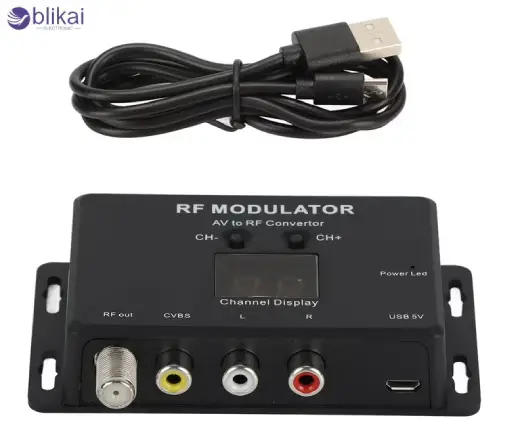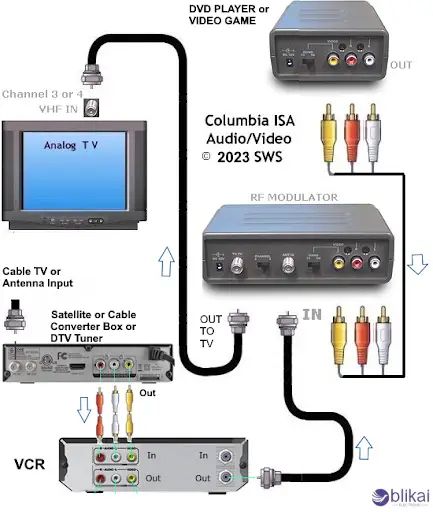RF Modulator: Types, Circuit Diagram & How It Works
Introduction to RF Modulators
RF modulator modifies the baseband audio and video into a modulated radio frequency (RF) signal. It is a vital part of analog and digital electronics. This enables the signal to be relayed to the coaxial cables and to be picked up by old television models and distribution systems that had the RF tuners.
Simply, RF modulators can be thought of as adapters that connect modern AV devices (i.e., DVD players or game systems) and anything that is RF-only. They were popular in usage prior to the standards of HDMI and other digital interfaces. The RF modulators are still used today on legacy systems, education broadcasting, closed-circuit television and building-wide signal distribution systems.

Types of RF Modulators
The RF modulators are available in numerous types that all have particular uses. These are the key ones:
Analog RF Modulators
The most conventional ones are the analog RF modulators. They accept composite video and mono or stereo audio signals and encode them into RF signals under one of several analog modulation schemes, such as amplitude modulation (AM) or frequency modulation (FM). The signal is the modulated signal then carried over a coaxial cable, usually on VHF or UHF channels.
These modulators are compatible with analog TV standards such as:
- NTSC (used in North America and parts of Asia)
- PAL (used in Europe, parts of Africa, and Asia)
- SECAM (used in France and some other regions)
They are simple and cost-effective but offer limited resolution and are susceptible to interference and signal degradation.
Digital RF Modulators
With the advent of digital broadcasting, digital RF modulators have gained popularity. These devices take high-definition digital signals (e.g., HDMI or SDI) and convert them into digital RF formats such as:
- ATSC (used in North America)
- DVB-T/DVB-C (used in Europe and many other countries)
- ISDB-T (used in Japan and parts of South America)
The digital modulators operate at a higher resolution (720p,1080p and in some cases, 4k) with quality audio and the number of programs per channel. Their use has become commonplace in current coax-based distribution systems where HDMI over IP or fiber is not viable.
Fixed Frequency vs. Agile RF Modulators
- Fixed Frequency Modulators transmit to a particular channel, generally CH3 or CH4 and are set in manufacturing.
- Agile Modulators give the user possibilities to select which channel is to be used without interference to listen through a substantial array of output frequencies for maximum compatibility.
Agile modulators will fit best in situations where several channels are to be distributed, just like hotel television setups, apartment communities or schools.
RF Modulator Circuit Diagram Explained
The internal organization of an RF modulator can hardly be comprehended without identifying the main elements that take part in the signal conversion and their role:
Oscillator
The high-frequency carrier wave is produced within the oscillator, and this is the foundation of the RF signal. The motive behind the choice of this frequency is determined by the output channel (e.g., 61.25 MHz channel 3 in NTSC systems).
Mixer
The baseband input, which is typically the audio and video signals, is passed through the mixer where it is combined with the carrier wave. The carrier signal amplitude, frequency or phase is changed by this modulation process in correlation with the input signal.
Modulation Methods
- AM (Amplitude Modulation): Used for video signals.
- FM (Frequency Modulation): Used for audio signals.
Some modulators use QAM or COFDM in digital versions.
Amplifier
The RF signal with modulation is not strong in the first place. This signal is amplified up to the desired range of -3dBm to +18 dBm by an amplifier, where coaxial cables can transport it.
Filters and Impedance Matching
- The high-density noise and any other unwanted harmonics are eliminated with the help of low-pass filters.
- Matching networks certify that the output impedance (which commonly has 75 ohms) is the same as the cable or load, so that the most power will be transmitted and a minimum reflection of the signal will be reflected.
How RF Modulators Work
The RF modulators are working on the assumptions of frequency translation. They modulate the signal into a higher frequency signal that cannot travel a long way or be detected by ordinary TV tuners, and this is called the baseband signal.
Here’s how the process works in sequence:
1. Signal Input: Baseband signals (composite video and audio) are fed into the RF modulator.
2. Carrier Generation: The oscillator produces a stable RF carrier at a selectable or fixed frequency.
3. Modulation: The baseband signal is mixed with the carrier, modulating its characteristics:
- Video is amplitude-modulated.
- Audio is frequency-modulated.
4. Amplification: The modulated signal is boosted for effective transmission.
5. Output: The RF output is delivered via coaxial cable to a TV, splitter, or distribution system.
This modulated signal can now be tuned and displayed on a compatible RF input device like a television set.

Applications of RF Modulators
RF modulators are used in a wide range of fields, particularly in systems where AV or HDMI inputs are unavailable or impractical:
Home Entertainment Systems
A connection device to bridge the gap between the use of VCRs, DVD, gaming boxes and set-top boxes that do not have baseband AV inputs with the TVs that have AV inputs.
CCTV and Security Systems
RF modulators allow video signals from multiple cameras to be viewed on specific TV channels over coaxial infrastructure.
Broadcast and Cable Distribution
Professional-grade modulators are used in headends to distribute content over coaxial cable to multiple TVs in hotels, hospitals, and schools.
Industrial and Educational Systems
Educational institutions use RF modulators to broadcast lectures and training content across campus using a coaxial network.
Legacy System Integration
They allow modern digital devices to connect to older television sets and monitors, also where legacy networks continue to exist in the world, such as in rural or developing regions.
Advantages of RF Modulators
Widespread Compatibility: Easily integrates with older TV systems.
Cost-Effective: Cheaper than HDMI over IP or fiber solutions.
Long-Distance Transmission: RF signals travel further over coaxial cable with less degradation than baseband AV.
Multi-TV Broadcasting: A single modulator can feed many TVs using splitters.
Disadvantages of RF Modulators
Low Image Quality: Especially for analog modulators, resolution and clarity are limited.
Interference Issues: RF signals are prone to electromagnetic and adjacent channel interference.
Obsolescence: Analog modulators are becoming outdated due to digital transitions.
Limited Bandwidth: Cannot support advanced features like subtitles, multiple audio channels, or data services.
Conclusion
The technology of transmission of signals cannot be characterized without RF modulators. How to work with them is the technique that is core to anyone in the electronics, broadcasting, or A/V installation and you might have to know how to connect a VCR to an old TV or you might need to be able to deliver an HD feed over a coax network.
The emergence of new interfaces that have displaced the older counterparts like High-Definition Multimedia Interface (HDMI), DisplayPort and IP-based streaming have meant that the RF modulators have remained as vital links between yesteryears and now. Exploring the use of analog or digital components, and determining how to read or produce a circuit map can make our AV networks stupendous regarding security and flexibility.
Some images are sourced online. Please contact us for removal if any copyright concerns arise.
Air Conditioner Capacitor Basics: What You Need to Know
Motherboard: The Core of Computer Hardware
Exploring Solenoid Switches: Principles and Applications
Difference Between Isolator and Circulator? [Guide]
How Does a Voltage Regulator Work? [Completely Explained]
How To Charge Lead Acid Battery: [Explained]
Semaphore in Embedded System
Transformer Core Faults: Hazards, Causes, Types, Testing, and Remediation
Arduino vs. Raspberry Pi: An In-Depth Contrast
Exploring Varied Types of Inverters










